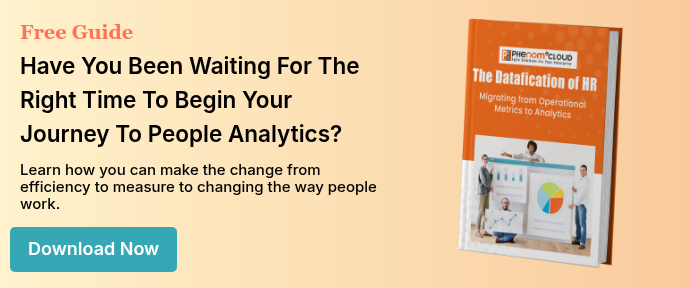
Sometimes reading the news and survey reports on people analytics give us the feeling that there is a hustle going on. We know that the information we generate in our human capital management platforms can help us make better predictions than using gut instinct. We see it happen every day in our work. But sometimes the dire prediction that your business will be marginalized if it doesn’t make a total investment in people analytics right now seems like hype.
Leading companies around the world have made a big leap into analytics, but CFOs wonder when they will see a return on investment. [1] We see dozens of quick hits where businesses had significant returns on a single initiative. However, in a 2016 study by The Economist Intelligence Unit, only two percent of respondents have had the organization-wide impact they seek.[2]
From our perspective, that’s normal. Business leaders and managers have been making people decisions based on gut instinct for their entire lives. If you have built a successful career on your personal judgment of people, it’s hard to trust that an algorithm will do a better job of predicting performance than you -- even when the evidence presents itself.
Finance and Marketing have embraced predictive and prescriptive analytics with excellent results, but that data is about money and customers. It is easy to think of them as theoretical constructs.
When we make decisions about people, it is personal. Changing your culture to data-driven decision- making about the individuals in your organization will take time.
Re-reading People Analytics in the Era of Big Data by Jean Paul Isson and Jesse Harriot[3] reminds us of the principle that guides our work: think big, start small. Isson and Harriot use that phrase to help us understand that trying to get support for a large initiative may be impossible, but the results of small success will begin to change minds.
You will not become a people analytics powerhouse overnight, nor should you try. As our experience has shown, we can start solving a single business problem to build momentum toward becoming data-driven.
- A motorized outdoor sports company needed to reduce new hire turnover in its sales force. A learner dashboard and training analytics solution gave them over 200% return on investment in the first year. Better management of new hire training improved their turnover, but the biggest gain was in sales.
- Companies in highly regulated industries find they can reduce their risk exposure using training analytics to monitor compliance.
Small successes like these start the conversation about using people data to improve business results.
Recommendation
We recommend HR and L&D leaders who haven’t yet been invited to the analytics party to partner with the people responsible for business KPIs. Take on a small initiative to move an organizational performance indicator. Work with your business partners to solve their problems by combining their data and yours.
That path is the fastest way to start changing your culture. You don’t have to make everyone a data guru or statistician. You only need to create a culture where people make decisions with the best available information. The rest will come.
References:
1. McCann, David. "CFOs Frustrated with Return on FP&A Investments." CFO. July 17, 2015. Accessed August 09, 2016.
2. The Economist Intelligence Unit. "Broken Links: Why analytics investments have yet to pay off." ZS Associates. 2016.
3. Isson, Jean Paul, and Jesse Harriott. People Analytics in the Era of Big Data: Changing the Way You Attract, Acquire, Develop, and Retain Talent. Hoboken: John Wiley & Sons, 2016. Print
PhenomᵉCloud is a comprehensive technology solutions provider committed to empowering businesses to overcome challenges, enhance their workforce capabilities, and achieve superior outcomes.

.jpg?width=220&height=125&name=The-Datafication-of-HR---opreational-mertics-to-people-analytics%20(1).jpg)

Leave a Comment